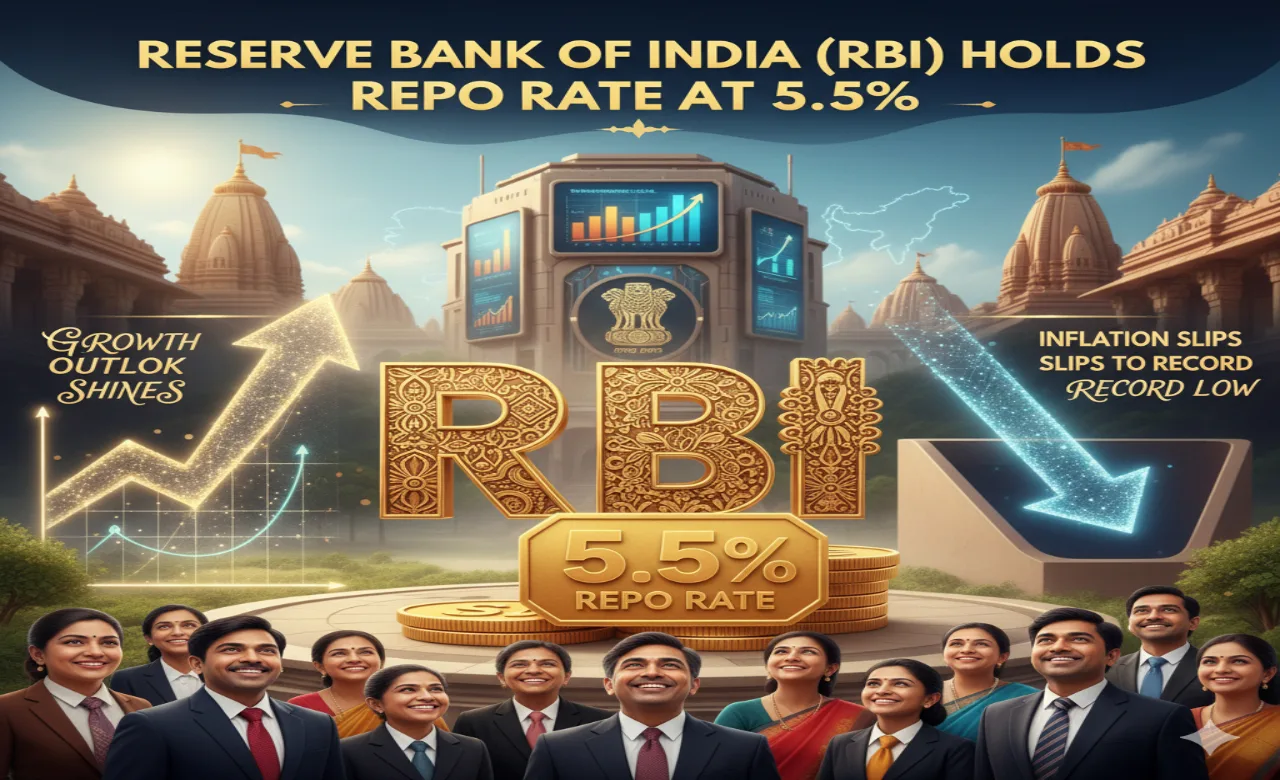The RBI has kept the repo rate unchanged at 5.5% while projecting a brighter GDP outlook of 6.8% for FY26. Inflation is now forecasted at just 2.6%, giving a boost to consumer confidence. With GST reforms, strong exports, and resilient domestic demand, India’s economy looks set for steady growth. Experts call this a “prudent and confident” policy in uncertain global times.
Key Takeaways on RBI Holds Repo Rate at 5.5%
- RBI keeps the repo rate unchanged at 5.5% with a neutral stance.
- GDP growth forecast for FY 2025-26 raised to 6.8% from 6.5%.
- CPI inflation outlook for FY 2025-26 lowered to 2.6%, down from 3.1%.
- The current account deficit narrowed sharply to 0.2% of GDP in Q1 FY26.
- Indian equity markets saw a steady upward trend during April–September 2025.
- RBI Governor Sanjay Malhotra assures no charges on UPI transactions.
- Exporters to benefit from extended repatriation timelines in IFSC accounts.
- Global agencies reaffirm India’s resilient growth story despite global headwinds.
RBI Monetary Policy: A Neutral Yet Optimistic Stance
The Reserve Bank of India (RBI), in its latest Monetary Policy Committee (MPC) meeting held between September 29 and October 1, 2025, announced that the repo rate will remain unchanged at 5.5%. This marks the second consecutive pause, signaling a balanced approach that safeguards financial stability while supporting economic momentum.
RBI Governor Sanjay Malhotra emphasized that the decision reflects confidence in India’s growth trajectory, even as global trade faces tariff uncertainties. The neutral stance provides businesses and investors with clarity and predictability, crucial in the current economic environment.
India’s Growth Story: Upgraded Forecasts Reflect Strength
- India’s growth momentum continues to impress, backed by strong domestic demand, investments, and supportive government policies. The RBI upgraded its GDP forecast for FY 2025-26 to 6.8%, compared to its earlier estimate of 6.5%.
- Q1 FY26 growth came in at 7.8%, the fastest pace in seven quarters, led by higher consumption and investment.
- Growth projections for FY26 are: Q2: 7.0%, Q3: 6.4%, Q4: 6.2%.
- For FY 2026-27, GDP growth is projected at 6.6%, assuming a normal monsoon and stable external conditions.
- Global institutions have also echoed this optimism. IMF, Fitch, S&P Global, OECD, and the United Nations have projected India’s growth between 6.3% and 6.9%, citing robust demand, strong services, and policy reforms as key drivers.
Inflation Hits Historic Low, Outlook Eases
In a remarkable development, RBI lowered the CPI inflation forecast for FY26 to 2.6%, down from its earlier projection of 3.1%.

Headline retail inflation dropped to an eight-year low of 1.6% in July 2025, before inching up slightly to 2.1% in August. This trend was largely supported by:
- A steep and prolonged food price decline of over 10%.
- Milder summer temperatures, reducing seasonal pressures.
GST rate rationalisation in September 2025, directly lowering consumer prices in nearly 11.4% of the CPI basket.
These developments have kept inflation well within the RBI’s target band, providing greater spending power to households and ensuring stable financial conditions.
Exports, Imports, and Current Account: Signs of Stability
India’s external sector remains steady despite global uncertainties. The current account deficit narrowed to just 0.2% of GDP in Q1 FY26, compared to 0.9% a year earlier. This was aided by:
- Strong services exports and resilient demand in IT and digital sectors.
- Robust private remittances, with inflows of US$ 35.3 billion, the highest globally.
- Merchandise exports rose by 2.5% and imports by 2.1% during April–August 2025.
Additionally, FDI inflows reached US$ 37.7 billion in April–July 2025, reinforcing India’s position as a preferred investment destination.
Equity Markets and Rupee Show Resilience

Indian stock markets remained strong during April–September 2025, despite brief volatility caused by tariff disputes and geopolitical tensions.
- BSE Sensex rose 3.9% in this period.
- BSE MidCap and SmallCap indices outperformed, climbing 7.7% and 12.1%, respectively.
The Indian rupee also remained one of the least volatile among emerging market currencies, supported by healthy forex reserves and strong macro fundamentals.
Real Estate and Corporate Reactions
Industry reactions to the RBI’s stance have been mixed.
- CREDAI and NAREDCO, leading real estate bodies, urged the RBI to consider rate cuts in future meetings to boost housing demand, especially for affordable homes.
- Developers welcomed policy stability, saying predictable borrowing costs help long-term planning and financing.
- Tata Capital’s CEO Rajiv Sabharwal hailed the decision as a sign of structural resilience, balancing growth and inflation expectations.
- CSB Bank’s MD Pralay Mondal called it a prudent move, citing RBI’s reforms aligning with global best practices like Basel-3 norms and enhanced support for exporters.
Relief Measures for Exporters
Amid rising U.S. tariffs on Indian goods, the RBI introduced measures to ease compliance for exporters. The central bank has extended the timeline for repatriating funds from foreign currency accounts in India’s International Financial Services Centre (IFSC) from one month to three months.
Also Read: RBI Grade B Recruitment 2025: Last Date to Apply Online for 120 Officer Posts at rbi.org.in
This step is expected to encourage more exporters to maintain accounts in IFSC Banking Units, boosting forex liquidity while providing exporters with greater flexibility.
No Charges on UPI Transactions
Governor Malhotra clarified that the RBI has no plans to impose charges on UPI transactions. This assurance is a major relief for millions of digital payment users and businesses relying on India’s fast-growing UPI ecosystem.

The RBI is also considering allowing lenders to remotely lock mobile phones purchased on credit in case of EMI defaults, a move aimed at reducing risks in retail lending.
India’s Economic Path Ahead: Resilient and Balanced
The latest monetary policy signals that India is well-positioned for stable growth despite a turbulent global backdrop. A combination of factors such as strong consumption, rising investments, steady government spending, low inflation, resilient exports, and robust remittances are driving confidence in the economy.
While challenges like tariff tensions and global slowdown risks remain, the RBI’s measured stance, structural reforms, and steady financial conditions provide a cushion. With a bright GDP outlook of 6.8% and record-low inflation, India is poised to remain one of the fastest-growing economies globally in FY26.
Spiritual Perspective: The Unique Knowledge of Saint Rampal Ji Maharaj Ji
While the Reserve Bank of India’s monetary policy reflects balance, stability, and growth in the economic sphere, true stability in life can only come through spiritual wisdom. Saint Rampal Ji Maharaj Ji imparts a unique and rare spiritual knowledge based on the holy scriptures of all religions. This divine knowledge not only answers unanswered questions about creation, purpose, and salvation but also provides practical solutions to overcome suffering, stress, and uncertainty in human life.
Just as India’s economy needs reforms and discipline to prosper, an individual’s soul requires the eternal truth revealed by Saint Rampal Ji Maharaj Ji to attain peace, happiness, and salvation. Those who adopt His teachings experience a life of clarity, simplicity, and freedom from social evils.
For more details on the true spiritual path, visit the official website: www.jagatgururampalji.org
FAQs on RBI Monetary Policy October 2025
Q1. What is the current repo rate announced by RBI in October 2025?
The Reserve Bank of India has kept the repo rate unchanged at 5.5% with a neutral stance during its October 2025 Monetary Policy Committee meeting.
Q2. What is the GDP growth forecast for India in FY 2025-26?
The RBI revised India’s GDP growth forecast for FY 2025-26 upwards to 6.8%, compared to the earlier estimate of 6.5%, citing strong consumption, investments, and supportive reforms.
Q3. What is the inflation outlook for FY 2025-26 according to the RBI?
RBI lowered the CPI inflation forecast for FY 2025-26 to 2.6%, down from 3.1%, supported by falling food prices, GST rate rationalisation, and favorable seasonal conditions.
Q4. How has India’s current account deficit changed in FY 2025-26?
India’s current account deficit narrowed significantly to 0.2% of GDP in Q1 FY 2025-26, from 0.9% in the same quarter last year, due to strong services exports and robust remittances.
Q5. Will UPI transactions attract charges after RBI’s policy update?
No. RBI Governor Sanjay Malhotra confirmed that there is no proposal to levy charges on UPI transactions, ensuring continued free digital payments for users.
















